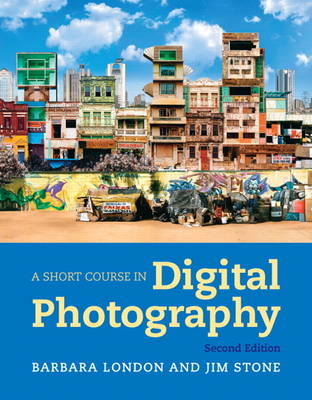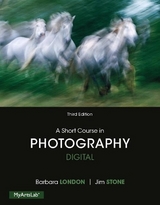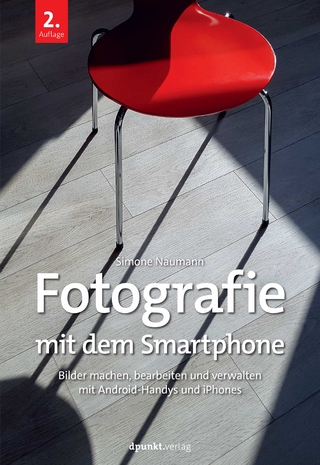
A Short Course in Digital Photography
Pearson (Verlag)
978-0-205-06642-1 (ISBN)
- Titel erscheint in neuer Auflage
- Artikel merken
The London, Upton, Stone series has helped over 1,000,000 photography students capture their potential.
After a very successful first edition, this second edition returns with the most up-to-date industry knowledge. Modeled after the long-running and widely used A Short Course in Photography, a brief text which presents the medium entirely in its most updated form.
Jim Stone is an Associate Professor of Photography at the University of New Mexico. His photographs have been collected by the Museum of Modern Art and The Smithsonian American Art Museum, among many others. Books of his work include Stranger Than Fiction (Light Work, 1993),Historiostomy (Piltdown Press, 2001), and Why My Pictures are Good (Nazraeli Press, 2005). He has also published six higher education titles that are widely used in university courses: A User¹s Guide to the View Camera, Darkroom Dynamics, Photography, Photography: The Essential Way, A Short Course in Photography, and A Short Course in Digital Photography. Barbara London has authored and co-authored many photography books from their first editions to their current ones, including Photography, Photography: The Essential Way, A Short Course in Photography, A Short Course in Digital Photography, The Photograph Collector's Guide, and more.
1 Camera 2
Getting Started Getting your camera ready 4
Focusing and setting the exposure 6
Exposure readout 7
Exposing images 8
What will you photograph? 9
Types of Cameras 10
Basic Camera Controls 12
More about Camera Controls 14
Inside a digital single-lens reflex camera 15
Shutter Speed Affects light and motion 16
Use it creatively 18
Aperture Affects light and depth of field 20
Use it creatively 22
Shutter Speed and Aperture Blur vs. depth of field 24
Getting the Most
from Your Camera and Lens 26
2 Lens 28
Lens Focal Length The basic difference between lenses 30
Normal Focal Length The most like human vision 32
Long Focal Length Telephoto lenses 34
Short Focal Length Wide-angle lenses 36
Zoom, Macro, and Fisheye Lenses 38
Focus and Depth of Field 40
Automatic Focus 41
Depth of Field Controlling sharpness in a photograph 42
More about Depth of Field How to preview it 44
Perspective How a photograph shows depth 46
Lens Attachments Close-ups and Filters 48
3 Light and Exposure 50
Sensor and Pixels 52
Pixels and Resolution 53
Color in Photography 54
White Balance 55
Using Histograms 56
Exposure Meters What different types do 58
How to calculate and adjust an exposure manually 60
Overriding an Automatic Exposure Camera 62
Making an Exposure of an Average Scene 64
Exposing Scenes that are Lighter or Darker than Average 66
Backlighting 68
Exposing Scenes with High Contrast 69
HDR High dynamic range 70
4 The Digital Darkroom 72
Equipment and Materials You’ll Need 74
Pictures Are Files 75
Digital Color Modes, gamuts, spaces, and profiles 76
Channels 77
Calibrating for accuracy 78
Working with Camera Raw 79
Setting up a Workflow Stay organized 80
Workflow programs: Aperture and Lightroom 81
Importing an Image 82
Scanning 83
5 Image Editing 84
Getting Started Editing an Image 86
Adjusting an Image Levels 88
Curves 90
Adjusting Part of an Image Selections 92
More Techniques
Layers 94
Retouching 96
Sharpening 98
Compositing 100
Color
into black and white 102
Filters 103
An Editing Workflow 104
Ethics and Digital Imaging 106
6 Printing and Display 108
Printers and Drivers 110
Papers and Inks 111
Soft Proofing 112
Panoramic Photographs 113
Presenting Your Work Framing 114
Matting a print 115
Mounting a Print Equipment and materials you’ll need 116
Dry Mounting a Print Step by Step 118
Bleed Mounting/Overmatting 120
7 Organizing and Storing 122
Image Storage 124
Using Metadata 125
Software for Organizing 126
Archiving Images and Prints 127
8 Lighting 128
Qualities of Light From direct to diffused 130
Existing Light Use what’s available 132
The Main Light The strongest source of light 134
Fill Light
To lighten shadows 136
Simple Portrait Lighting 138
Using Artificial
Light Photolamp or flash 140
More about Flash How to position it 142
Using Flash 144
9 Seeing Like a Camera 146
What’s in the Picture The edges or frame 148
The background 150
Focus
Which parts are sharp 152
Time and Motion in a Photograph 154
Depth
in a Picture Three dimensions become two 156
Chaos becomes order 157
Photographing for Meaning 158
Portraits Informal: Finding them 160
Formal: Setting them up 162
Photographing the Landscape 164
Photographing the Cityscape 166
Photographing Inside 168
Responding to Photographs 170
10 History of Photography 172
Daguerrotype “Designs on silver bright” 174
Calotype Pictures on paper 176
Collodion Wet-Plate Sharp and reproducible 177
Gelatin Emulsion/Roll-Film
Base Photography for everyone 178
Color Photography 179
Early Portraits 180
Early Travel Photography 182
Early Images of War 183
Time and Motion in Early Photographs 184
The Photograph as Document 185
Photography and Social Change 186
Photojournalism 188
Photography as Art in the 19th Century 192
Pictorial Photography and the Photo-Secession 193
The Direct Image in Art 194
The Quest for a New Vision 195
Photography as Art in the 1950s and 1960s 196
Photography as Art in the 1970s and 1980s 198
Digital Photography Predecessors 200
Becomes Mainstream 202
How to Learn More 204
Troubleshooting 205
Photographers’ Web Sites 210
Glossary 212
Bibliography 216
Photo Credits 217
Index 218
| Erscheint lt. Verlag | 5.5.2011 |
|---|---|
| Sprache | englisch |
| Maße | 210 x 272 mm |
| Gewicht | 600 g |
| Themenwelt | Kunst / Musik / Theater ► Fotokunst |
| Sachbuch/Ratgeber ► Freizeit / Hobby ► Fotografieren / Filmen | |
| Kinder- / Jugendbuch ► Sachbücher ► Kunst / Musik | |
| ISBN-10 | 0-205-06642-9 / 0205066429 |
| ISBN-13 | 978-0-205-06642-1 / 9780205066421 |
| Zustand | Neuware |
| Informationen gemäß Produktsicherheitsverordnung (GPSR) | |
| Haben Sie eine Frage zum Produkt? |
aus dem Bereich



